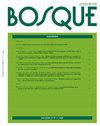用于三种含羞草高质量幼苗生产的新型堆肥管
IF 0.6
4区 农林科学
引用次数: 0
摘要
获得高质量的本地物种幼苗和可持续的幼苗生产替代品是目前在退化生态系统中成功恢复种植的一些瓶颈。本研究在混交林植物地理区域内,用110 cm3、55 cm3聚丙烯管和58 cm3 SISBGC型生物堆肥容器分别培育了含羞草(Mimosa flculosa)、微翅草(M. micropteris)和金翅草(M. incana)种子幼苗,对其生态恢复效果进行了评价。测定了成活率、总高、茎粗、茎、根干生物量、结实商、迪克森品质指数和技术效率。在所有评估和三个容器中,三种含羞草的成活率都较高,平均超过95%,证明了所采用的育苗方案的可行性。虽然110 cm3的管材有利于幼苗的生长,尤其是小花茅,但SISBGC管材对小花茅和白花茅的生长效率相似。综上所述,SISBGC在苗圃中的良好表现,以及其生物分解特性,使其成为生产用于生态恢复目的的本地幼苗的绝佳选择。本文章由计算机程序翻译,如有差异,请以英文原文为准。
New compostable tubes for the production of high quality seedlings of three species of Mimosa spp
Obtaining high-quality native species seedlings and sustainable alternatives for seedling production are currently some of the bottlenecks for successful restoration plantings in degraded ecosystems. This study evaluated the survival and vigor of seminal seedlings of Mimosa flocculosa, M. micropteris and M. incana, produced in three containers (110 cm3 and 55 cm3 polypropylene tubes and 58 cm3 SISBGC type biocompostable container) for ecological restoration purposes in the phytogeographic region of Mixed Ombrophilous Forest. Survival, total height, stem diameter, shoot and root dry biomass, sturdiness quotient, Dickson’s quality index and technical efficiency were evaluated. Survival percentages were higher for the three Mimosa species throughout all evaluations and in the three containers, with an average over 95 %, demonstrating the viability of the seedling production protocol used. Although the 110 cm3 tube favored larger seedling growth, especially in M. flocculosa, the SISBGC tube showed similar efficiency for M. micropteris and M. incana. We conclude that a good performance in the nursery, associated with the bio-decomposition characteristics, makes SISBGC an excellent alternative for producing native seedlings for ecological restoration purposes.
求助全文
通过发布文献求助,成功后即可免费获取论文全文。
去求助
来源期刊

BOSQUE
Agricultural and Biological Sciences-Forestry
CiteScore
0.70
自引率
0.00%
发文量
0
期刊介绍:
BOSQUE publishes original works in the field of management and production of forestry resources, wood science and technology, silviculture, forestry ecology, natural resources conservation, and rural development associated with forest ecosystems. Contributions may be articles, rewiews, notes or opinions, Either in Spanish or English.
 求助内容:
求助内容: 应助结果提醒方式:
应助结果提醒方式:


